Seeing the Unseen: Why Observability is Crucial for Corporate Banking
- Sep 15, 2025
- Blogs
- 7 min read
The Complex World of Corporate Banking
Corporate banking serves large enterprises, MNCs, government entities, and high-net-worth clients. Each client engagement tends to be relationship-driven, customized, and strategic, often involving complex financial structures across multiple locations.
Most of the services cater to critical, time-sensitive, and high-value financial transaction flows in corporates. Here’s a quick overview of the typical functions and workflows in corporate banking:
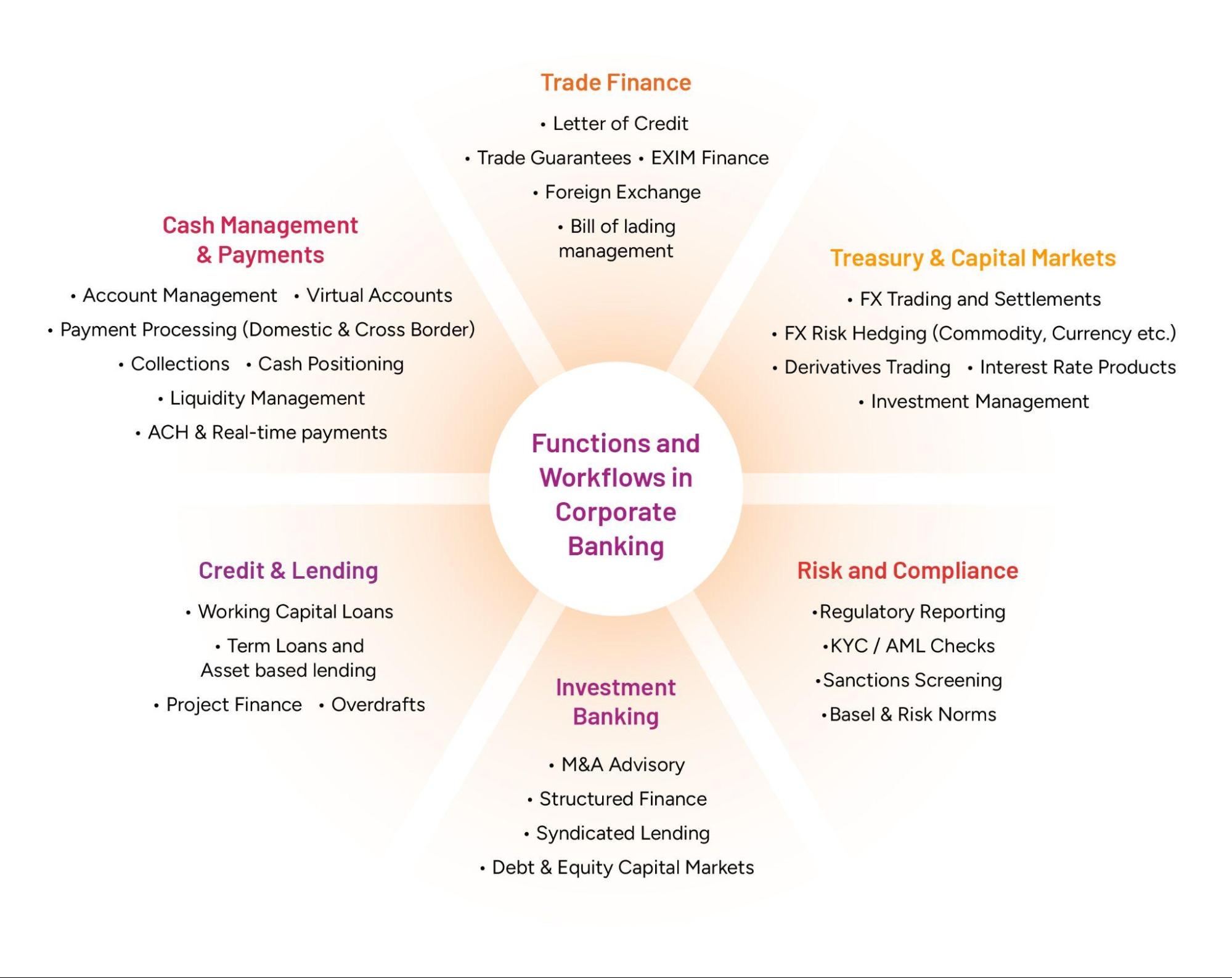
Fig 1: Corporate banking functions
These workflows are not simple. They traverse multiple interconnected systems, partner interfaces, document flows, and compliance checks while adhering to strict SLAs and client expectations. These include:
- Core banking systems (CBS), Payment gateways, and Clearing systems
- APIs, ERP integrations, and third-party fintechs
- Trade finance, Credit, and Treasury operations
- Virtual account platforms and FX trading engines
- Regulatory compliances like Basel IV, ISO20022, DORA, SEBI, etc.
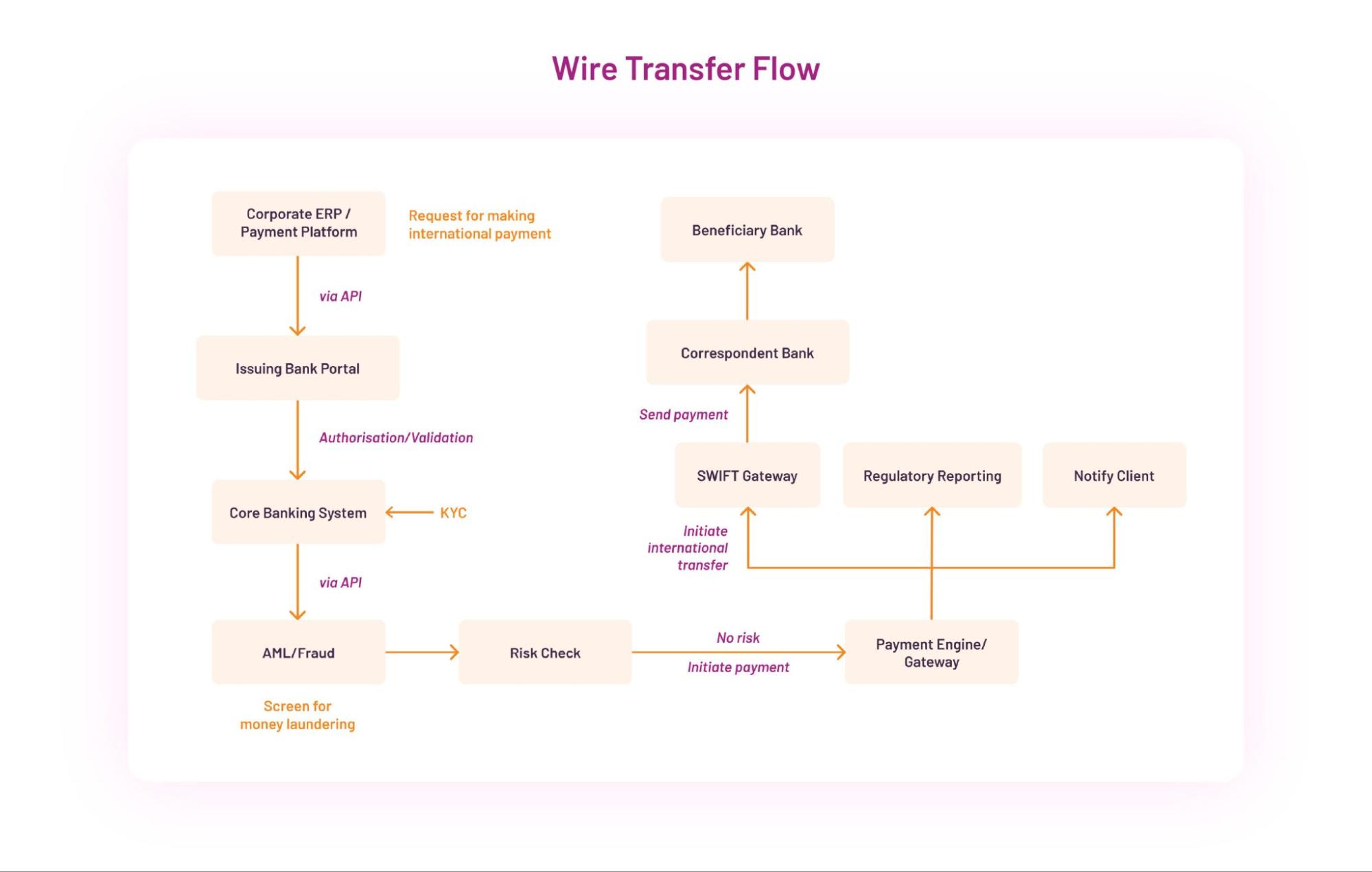
Fig 2: Sample international payments flow in corporate banking
Corporate banking clients demand always-on service with instant updates, and they expect all these services to be delivered digitally and instantly. Their expectations include:
- Banking-as-a-service that embeds banking within their system, enabling 24×7 and real-time account management, automated reconciliations, and instant payments
- Virtual account support for centralized cash control across business units and geographies
- Customised AI-driven tools that provide real-time insights into liquidity, working capital, credit risk, payments, settlements, FX exposure, and more.
- GenAI-powered frontlines offering personalized, informed interaction and quicker resolutions
- Regulatory compliance with timely reporting, AML, and ESG transparency
- Non-intrusive, agent-less API-based integration with their ERP, TMS, and accounting platforms
How Banks Are Responding and What’s Holding Them Back?
To meet these rising demands, banks are evolving. Some are building new digital platforms, while others are partnering with fintechs to extend capabilities. Many are investing in modern technologies like event-driven architecture, Kafka queues, structured logging,and API-first systems.
However, transformation isn’t easy. Most banks still rely on legacy systems extended over time through integrations and bolt-on solutions, resulting in a fragmented infrastructure characterised by
- Silo-ed and inconsistent data formats across documents, systems, and partners
- Minimal context of event and data limiting complete visibility across the transaction journey, like payments, settlements, and cash flow
- Complex integrations and APIs that increase the risk of failure
- Challenges in adopting newer compliance standards, such as ISO 20022
In corporate banking, where timing, precision, and reliability are key, such a fragmented infrastructure could cause SLA breaches, FX mismatches, and reconciliation errors, which don’t surface easily due to poor visibility.
Why Business Observability is the Missing Link
Tracking every step across these high-value, time-sensitive workflows is incredibly complex. But it is essential to have complete visibility and measurement of these journeys across technology, data, transactions, and users. Business observability provides visibility by:
- Tracking multi-step workflows (e.g., trade finance or payments) across internal and external systems
- Correlating events across data pipelines, applications, and infrastructure
- Generating real-time alerts when failures or delays occur
- Delivering insights to help operations teams take proactive actions
- Using AI/ML to predict risk and optimize performance
- Empowering frontline teams to provide quick resolutions and proactive communication through an intuitive dashboard – extensible to clients too
Whether it’s a failed FX trade, a missed Letter of Credit (LC) expiry, delayed reconciliation, or a liquidity mismatch, observability identifies the issue early, helps resolve it fast, and prevents it from recurring.
How VuNet Helps: Built for Banking, Designed for Complexity
VuNet’s Business-Centric Observability Platform, vuSmartMaps™, is purpose-built for the challenges of modern banking. It is a next-generation full-stack observability solution built using big data and machine learning to monitor business journeys and improve transaction experiences.
The platform’s business-centric approach ensures that technical performance is always viewed through its business impact, making it ideal for the relationship-driven nature of corporate banking.
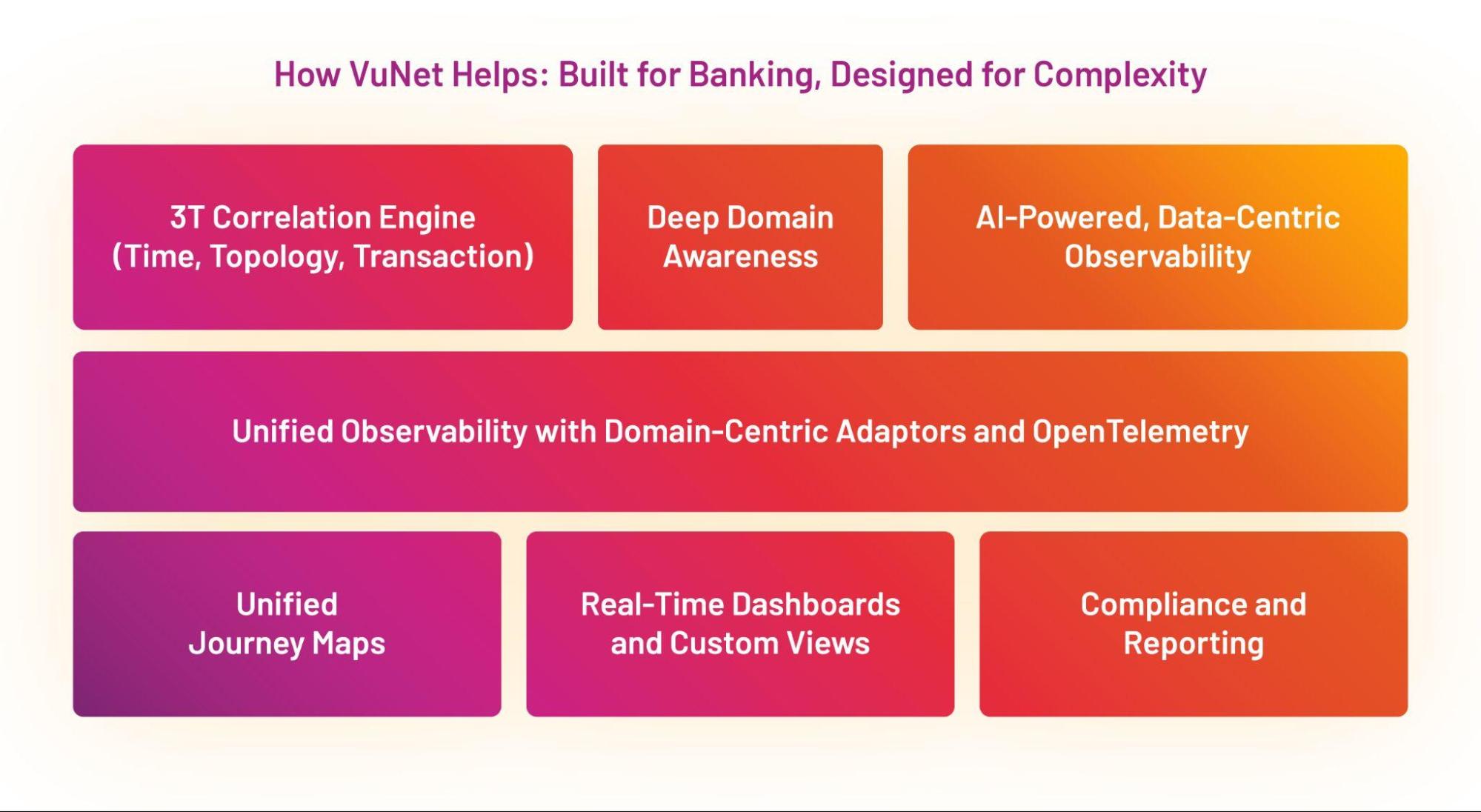
Fig 3: VuNet Platform’s capability for corporate banking
Key Capabilities:
- Deep Domain Awareness
VuNet understands banking processes (such as customer onboarding, payments and settlements, KYC authorizations, EOD reconciliation, and regulatory reporting) and the complexities involved in these workflows spanning multiple systems and APIs, involving batch jobs, manual steps, and validations. We have built this domain knowledge into our platform, enabling real-time monitoring of critical operations.
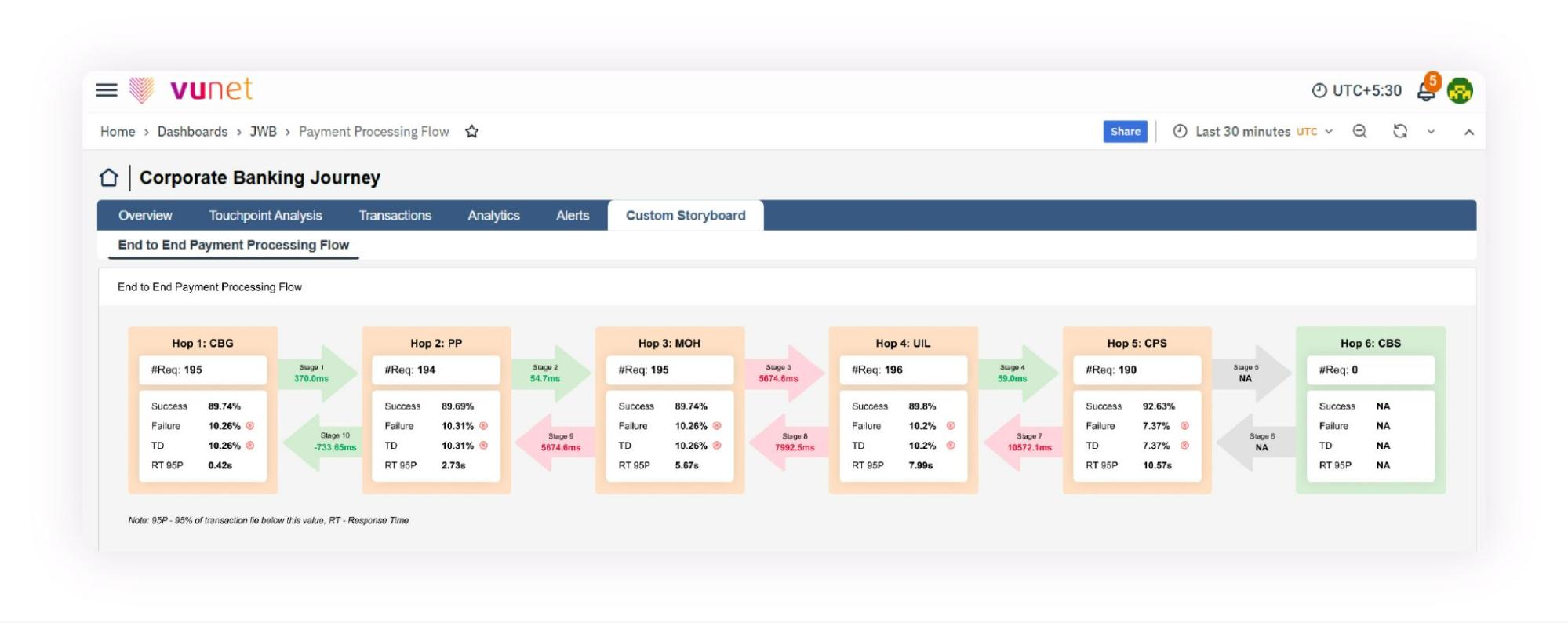
Fig 4: Sample view of end-to-end payment processing flow in VuNet’s Platform
- 3T Correlation Engine (Time, Topology, Transaction)
Our patented correlation engine links fragmented signals and data into a unified view so you see what failed and why it failed.
- AI-Powered, Data-Centric Observability
AI/ML models detect anomalies, provide RCA, predict issues, and reduce alert fatigue—enabling smarter, faster decision-making.
- Unified Observability with Domain-Centric Adaptors and OpenTelemetry
Our platform supports real-time data ingestion via OpenTelemetry Protocol and banking-specific adaptors with minimal changes to legacy systems. This helps preserve data fidelity while reducing infrastructure complexity.
- Unified Journey Maps
Visualize each transaction from cash flows to settlements and forex in a real-time graph view, including dependencies, APIs, and system touchpoints.
- Real-Time Dashboards and Custom Views
From cash position to SLA monitoring, VuNet delivers custom dashboards for ops, risk, compliance, and client teams. Proprietary features like User Experience Index (UEI) help measure and improve user experience.

Fig 5: Sample dashboard view in VuNet’s Platform
- Compliance and Reporting
The platform enables unique banking compliance requirements through audit-ready reporting and traceability enabled by capturing enriched data for every transaction journey..
Capabilities That Meet Banking’s Unique Needs:
Banking operations rely heavily on APIs to connect with partner ecosystems and batch jobs & asynchronous flows to process large, critical workloads. Most of these critical workflows involve manual steps such as scrutiny, authorizations etc. VuNet’s platform brings the visibility needed to ensure reliable performance of these workflows. Here’s how:
API Performance Governance and Security
Continuously ingest and correlate logs from APIs involved in key workflows like payments, authentication, and authorization. Monitor API latency, detect failures, pinpoint root causes (such as integration or payload issues), flag suspicious activity using AI/ML, and analyse performance trends by client or other parameters.

Fig 6: Sample dashboard showing API insights
Batch Jobs Performance Visibility and Reliability
Ingest and correlate batch job logs to validate and enrich data. Map job dependencies to offer a complete view of transactions, helping detect and prevent downstream impact from delays or failures. Enable automated retries to reduce manual intervention.
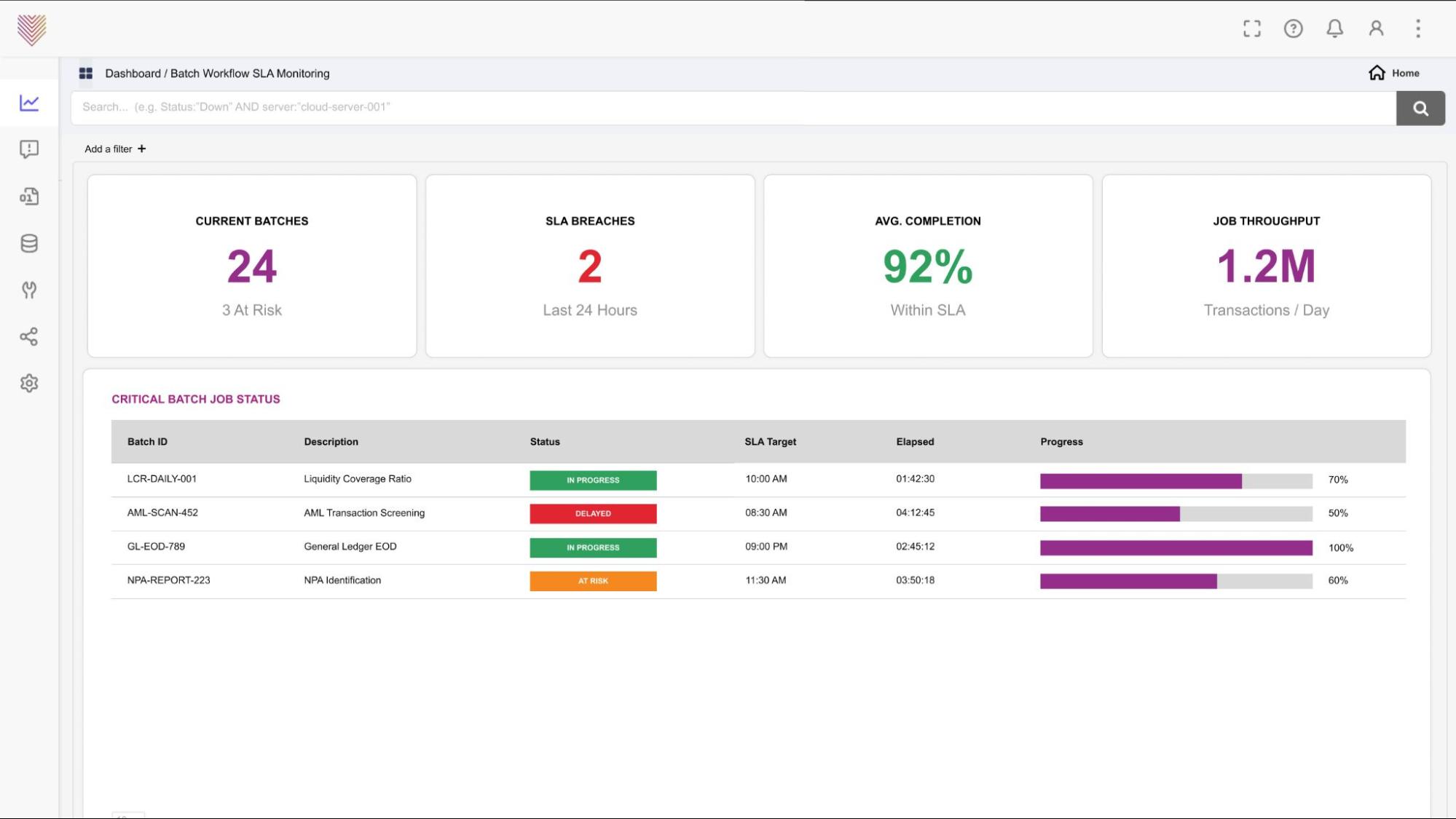
Fig 7: Sample Dashboard displaying health and performance of Batch Jobs
Asynchronous Jobs Visibility
Track asynchronous calls in a transaction journey and provide the true TAT of a transaction. By tracking transaction and session IDs across logs, metrics, events, and traces and stitching the data to form a journey view, complete visibility of a transaction journey is provided. This helps assess the true impact of any delays in the transaction on customer experience.
Examples of Corporate Banking Observability Use Cases and VuNet Solution
| Function | What Banks Expect | Sample Use Case | What VuNet Enables |
|---|---|---|---|
| Credit & Lending | Transparent loan processing, real-time status updates, and adherence to SLAs | Monitor corporate loan disbursement and documentation workflows | Track each step of the loan journey across systems (such as LOS, CBS) and flag delays/bottlenecks |
| Faster loan approvals, zero missed documents | SLA tracking for loan approvals, disbursals | Provide real-time status dashboards, exception alerts for delays | |
| Trade Finance | Timely LC issuance, predictable timelines, and minimal manual follow-ups | Document journey visibility (LC, invoices, guarantees) | End-to-end monitoring of document flow (OCR, trade systems, workflow engines, compliance); detect processing delays |
| Seamless global trade processing | Real-time view of trade transactions & SWIFT messages | Tracks messaging timelines across internal/external nodes; Alerts for delays, rejections, or failures | |
| Treasury & Capital Markets | Speed and accuracy in deal execution, no pricing lags | Monitor the Forex and treasury deal lifecycle | Track transaction journey and alert for latency and failures |
| High data quality from market feeds | Visibility into investment booking and confirmations | Detects lags or mismatches in the capital market order journey | |
| Investment Banking | Full visibility into the deal lifecycle, reliable data from third parties | Deal management and approval workflow monitoring | Tracks multi-stage approval workflows and detects where delays occur; supports proactive escalation |
| No delay in capital market data access | Visibility into data feeds and partner API performance | Ensures feed/API health from partners (e.g., market data providers, exchanges); flags missing or stale data | |
| Cash Management & Payments | Payment processing without delays/errors, accurate file acknowledgments | Bulk payment file monitoring (Receivables/Payables) | Tracks the file journey from upload to settlement; detects rejections, duplicates, system errors, and alerts relevant teams |
| Real-time payment status, instant confirmation | RTGS/NEFT/IMPS/SWIFT transaction observability | Provides real-time health dashboards and root cause of delays; connects CBS, Payment Gateway, and external switches | |
| Risk & Compliance | Compliance without penalties, visibility into process SLAs | Regulatory reporting (e.g., KYC/AML) | Tracks report generation workflows, SLA adherence, and compliance delays; alerts for missed deadlines. Provides a dashboard to the compliance team |
| Predictive insights to flag risks early | Risk event detection & exception alerting | Uses AI to detect outliers (e.g., unusual processing time, missing controls); maps them to potential risk | |
| Relationship Management & CX | Transparency into service experience, proactive communication | Visibility into client journeys across services | Offers client-centric dashboards for RMs; shows payment failures, onboarding status, and SLA breaches – enabling proactive action |
| Avoid escalations, get early alerts on issues | Proactively address issues with clients | Enables Customer support teams and relationship managers to view alerts before escalation. Helps in quick recovery and confidence-building | |
| IT Operations | Faster issue detection and resolution, minimal downtime | Root cause analysis for multi-tier system issues | Correlates logs, metrics, and traces; detects upstream/downstream impact and root cause of journey slowdowns/failures |
| Less manual effort, quicker resolution | Automation of alert-to-incident workflows via ITSM | Pushes rich, contextual alerts with root cause, severity, and affected systems to ITSM tools | |
| Fraud | Early fraud detection, pattern visibility | AI-based anomaly detection on large value/unusual transactions | AI models flag suspicious patterns e.g., after-hours activity, high-value anomalies, repeat retries |
| Account protection, fewer false positives | Pattern-based anomaly detection (e.g., login IP anomalies, failed OTPs) | Monitors behaviour across time, IP, device, frequency; correlates with access/authentication issues | |
| Data & Insights | End-to-end visibility into KPIs, actionable insights by function | Journey analytics dashboards across functions | Visual dashboards for CXOs, Ops, and IT with volumes, SLAs, drop-offs, and latencies across services. |
| Predictive capabilities for capacity planning | Volume forecasting for peak events | Uses historical and contextual data to project spikes (e.g., quarter-end, tax season); enables proactive action. |
Key Benefits of VuNet’s Business Observability:
Proactive Risk Management
- Actionable insights on SLAs, risks, and key business metrics to drive smarter planning and faster decisions
- Real-time compliance monitoring and regulatory adherence
Enhanced Client Experience
- Proactive communication about service issues and resolutions
- Faster issue resolution through automated workflows
Operational Excellence
- End-to-end visibility across transaction journeys
- Automated detection and handling of exceptions
Regulatory Compliance
- Continuous monitoring of regulatory SLAs, automated reporting, and validation for compliance submissions
- Complete audit trails with timestamped traceability of every transaction
Final Thoughts
Corporate banking is evolving and becoming faster, more connected, and more demanding. To keep up, banks must do more than digitize. They need deep, real-time visibility across every transaction, system, and interaction.
Business observability can be a strategic advantage. It gives banks the power to see what’s happening, understand why, and act before the impact grows.
With VuNet, banks don’t just see more, but they understand more, act faster, and build stronger relationships with their most valuable clients.
Table of Contents
- The Complex World of Corporate Banking
- How Banks Are Responding and What’s Holding Them Back?
- Why Business Observability is the Missing Link
- How VuNet Helps Built for Banking, Designed for Complexity
- Capabilities That Meet Banking's Unique Needs
- Examples of Corporate Banking Observability Use Cases and VuNet Solution
- Key Benefits of VuNet’s Business Observability
- Final Thoughts










